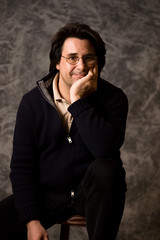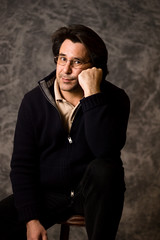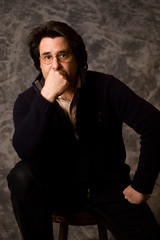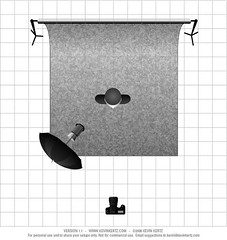Single Light Portrait
I've been working on single light portrait techniques trying to use what I've learned on Strobist and in "Light Science & Magic" by Hunter, Biver and Fuqua.


First off ... let's cover the equipment:
- Camera: D70s (ISO 200, WB Flash, Manual Mode)
- Lens: Nikkor 50mm f/1.4 (like using a 75mm on a film camera)
- Strobes: SB-800 & SU-800
- Modifier: 43" White, Shoot-through umbrella
- Stand: Westcott & Justin clamp
- Background: mottled, gray muslin
The D70s will sync at high shutter speeds (1/500) than most cameras so, I wanted to make sure that I took advantage of that. The way I came to the exposure was I started by setting the shutter speed to 1/250th and snapped some images without the flash firing until the image was completely black. (Note: that the normal room lights were at about 50%.
This gave me an exposure setting of 1/250th @ f/8. I didn't want the background to reflect much of the warmer ambient light if I could help it. Now, I knew that I didn't want to have the background in focus so I opened the f-stop up to f/1.4 and increased the shutter speed to 1/500th.
For those of you doing the math that would actually give me about a 2 stop underexposure of the background instead of completely black which was tolerated for this shot. Then I would chimp in the amount of flash power needed.
When I set up the umbrella, there were two things that had always concerned me. 1) is the flash set to the right zoom amount to fill the umbrella and 2) how can I get the flash head to point to the center of the umbrella. Previous attempts just didn't seem to get a nice soft, well balanced light even when I shot through the umbrella.
 I set up the umbrella so that it would reflect the light instead of shooting the flash through the umbrella. Then, instead of using the flash shoe on the umbrella holder I put a Justin clamp on the post underneath the holder and positioned the flash head so that it pointed straight up the umbrella shaft into the center. I think that this was the first big improvement that I made to the setup.
I set up the umbrella so that it would reflect the light instead of shooting the flash through the umbrella. Then, instead of using the flash shoe on the umbrella holder I put a Justin clamp on the post underneath the holder and positioned the flash head so that it pointed straight up the umbrella shaft into the center. I think that this was the first big improvement that I made to the setup.Once the flash was positioned, I triggered the flash and moved the umbrella closer or further away from the flash until (at 50mm zoom) the light filled the umbrella without spill. That was the second big improvement I made to the setup.

After that, the setup was pretty traditional. I positioned the umbrella at a 45 degree angle to the subject camera left and raised it so it pointed about 30 degrees down to the subject. I made some further adjustments as I shot to get some light on the background in order to give some definition to the outline of the subject.
The SB-800 was set to remote and assigned to Group A/Channel 3. I was able to control it from the SU-800 that was on the camera. The group and channel combination are not that important here. The SU-800 and SB-800 allow me to use any combination of Group/Channel. Group A/Channel 3 just happens to be what I chose and had nothing to do with the only group/channel combination on the D70s to fire a remote flash using the built-in flash in Commander Mode. (See Strobist Style with a Nikon D70s). The SU-800 takes the D70s' limitation out of the picture.
The flash ended up being set to 1/128th power for the entire shoot and was positioned about a meter from the subject. The subject was almost 2 meters from the background, this gave a nice fall-off of the light but still added definition to the subject with just enough light hitting it.
Then, with my trusty ML-L3 remote, I fired away. I was really looking to get that triangle of light described in Light Science & Magic under the left eye in this case.
In the next session I'll compare this setup to a setup with the addition of a reflector camera right to lift some of the shadow from the unlit side of the subject.



3 comments:
Hi,
Although i've been shooting for quite a few years with natural light, i recently started with flash.
I've got a Nikon D70s with an SB800. I use the pop-up as a remote commander to use the SB800 as a wireless remote flash. Very easy.
My question: last weekend i was shooting in bright sunlight and i wanted to shoot against the sun using the flash to lit the subject (a little more than fill-flash), trying to get that fashion-picture feeling. I put the camera to manual and made sure the exposure was correct for the background. Then i shot and the sb800 lit the subject beautifully. The result was great and i was happy with the nice light on the pictures.
But here's the problem, and the question: in the old days when i shot without a flash, i could set my aperture to 2.8 and have a really beautiful blurry background. But now, because of the flash sync speed limitation, i couldn't get faster than 1/500th which meant that my aperture couldn't be wide open. Do you have any idea what the solution might be? I wasn't using a tele, so the background is very sharp with an aperture of f11 ! I read somewhere, although i don't fully understand, that i can use a non-ttl pc cord and trick the camera into believing there's no flash attached so i can flash at 1/8000th with the D70s. No idea if this is true though...
I hope you have the time to help me out. I would very much appreciate this and from what i saw on your website, you are a master at controlling light and using flash.
Also, why would anyone use a SU800 instead of the built-in pop-up commander of the D70s?
Thanks in advance.
Best,
Kris
Kris ... the D70s is a great camera for high-speed flash syncing! Unfortunately, I have not messed with the process and would not be confident explaining it. But he's a link to Strobist article that talks about it at length: Control Your World With Ultra-High Sync
As for the SU-800 that I use ... the D70s built in flash is good for firing multiple flashes all on Channel 3 in Group A. But, if you have multiple flashes and want to put them in different groups (A, B or C) to give them their own separate power level assignments, you can't do that with the single group capability of the D70s built-in flash. Plus, if other photogs are around and they're using Channel 3 or all using D70s' your flashes will go off when they fire their shutters. So, the SU-800 allows me to set different settings for separate flash groupings and allows me to do that using any one of three channels.
Does that help?
MD! I've stumbled across you! Do you and your lovely have a more personal blog, or is this as personal as it gets?
Good to see you!
:) Chicken Mama . . . oh, and that guy I live with.
Post a Comment